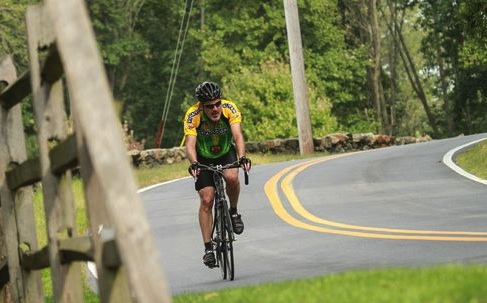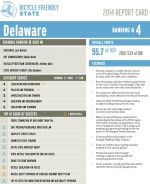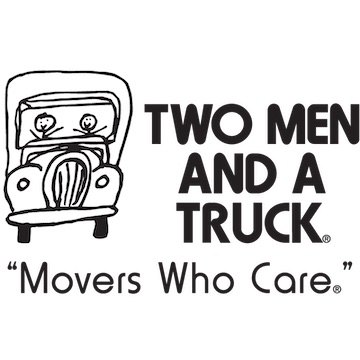News Journal: “Can motorists, bicyclists share the road?”

 by Melissa Nann Burke
by Melissa Nann Burke
Published in The News Journal
September 21 2014
Every road-riding cyclist has a story about a time a motorist came within inches of killing them.
A car recently ran John McCormick off the road when turning into the Brandywine Town Center from Naamans Road in Brandywine Hundred, he said.
McCormick recovered and followed the driver to where he’d parked.
“‘Hey, why’d you cut me off?’ ” McCormick asked him.
“He said, ‘I never saw you.’ And I believed him.”
The hit-and-run death of 27-year-old cyclist Phillip Bishop on Brackenville Road on Sept. 12 is another stark reminder of the vulnerability of cyclists on roadways built for and dominated by automobiles. Bishop follows the death of Eloy Sandoval, 44, who was killed crossing Del. 273 near Ruthar Drive on his bike July 25, and the 99 cyclists injured in crashes so far this year.
Delaware had one of the highest average rates of bicyclist deaths per capita from 2008-12, behind only Florida, according to analysis by the National Highway Traffic Safety Administration.
Due to the differentials in speed and mass, a cyclist almost always fares worse in a motor-vehicle collision. However, it’s relatively rare for a cyclist to be killed by a car: The First State averaged three cyclist fatalities a year for the last decade, representing 2.76 percent of all traffic deaths. The national rate for cycling fatalities is 2 percent.
There’s disagreement about how to make things safer.
Some seek changes to laws and infrastructure to account for the differences between bicycles and cars. Others insist cyclists should get over their inferiority complex and claim their roadway rights – swearing off bikeways and bike lanes.
“We need to improve and make things safer, but we don’t need to tell cyclists to get off of certain roads,” said Amy Wilburn, chair of the Delaware Bicycle Council, which advises state agencies on cycling matters.
“We have motorists who don’t know how to interact with cyclists, and cyclists who don’t know how to interact with motorists. There hasn’t been enough education, in my opinion.”
Man vs. machine

Bicycling on one of Delaware’s beautiful, but narrow, roads.
The Brandywine Valley is popular among veteran cyclists who consider its rolling hills and covered bridges some of the best and most challenging road-riding terrain on the East Coast.
The 62-mile Gran Fondo, the longest of the Wilmington Grand Prix races, zips along these back roads in spring, passing near the wooded stretch of Brackenville Road where Bishop was killed – a winding, two-way thoroughfare with no shoulders.
Kristie Sullivan Perry, who lives a half mile from the crash site, fears for the cyclists and runners that use her road.
“Whenever I’m driving, I think, ‘Oh God, they are going to get hit,’ ” Perry said last week.
Should a motorist lose control of their vehicle, cyclists have “nowhere to go” to avoid a collision, Perry said.
Delaware is among the states that has adopted a Vulnerable User Law, placing extra responsibility on drivers to avoid harming cyclists and pedestrians. Pardo – who ran but later turned himself in – faces a dozen years of mandatory minimum prison time, if convicted. He is charged with criminally negligent homicide and leaving the scene of a fatal crash.
There’s no history of fatal cycling crashes in the areas surrounding Brackenville Road.
Such crashes occur more often on higher-traffic arteries with shoulders, including U.S. 40, Old Baltimore Pike, Del. 41 and 273, according to state data, said Adam Weiser, director of traffic safety programs for the Delaware Department of Transportation.
In 2011, Delaware adopted a law requiring motorists to keep a “reasonable and prudent distance” of at least three feet from cyclists while passing. When approaching a cyclist traveling the same direction, the cyclist has the right of way.
And while the law is to “share the road” in Delaware, many motorists haven’t gotten the memo. Wilburn and others are working to incorporate units on bicycle safety into driver’s education and remedial driving courses, as well as an educational online video.
“People don’t get exposed to a lot of these messages for cycling,” Wilburn said. “I really would like to see more spent and more of a concentrated effort on education.”
The state partners annually with community groups to train foreign students working in Delaware’s beach resorts on bike safety for their summer stays.
A formidable challenge is the attitude of some drivers that cyclists don’t belong on the roads at all. Cyclists who flagrantly disregard red lights or stop signs, or illegally ride against traffic don’t help their case, McCormick noted.
He and his wife, Cecilia, who live in Wilmington, are certified by the League of American Bicyclists to teach a safety course to build up cyclists’ confidence on the roads. They advise their students to be visible, predictable, courteous, yet assertive.
“As a cyclist, there’s not much you can do about a distracted or impaired driver, or someone who disobeys the rules of the road,” he said. “It’s a risk that you take if cycling is your lifestyle or hobby.”
We’re No. 4
Delaware recently catapulted through the League of American Bicyclists’ rankings of bicycle-friendly states, going from No. 31 to No. 4 within five years. That’s largely due to the 2012 initiative by Gov. Jack Markell to pump millions into funding for trails and pathways (several are still being designed). The ranking also recognizes policies, laws and bicycle education for police and students.
“The complaint I hear most [from cyclists] is we’re not doing enough,” said Weiser of DelDOT. “There is more that can be done. But not a lot within the limits of the money available.”
Delaware actually spends more – 3.7 percent – of its federal transportation dollars on bike and pedestrian projects than any other state, according to Federal Highway Administration figures.
The group Bike Delaware would like to see DelDOT next incorporate bicycle-centric projects into its federally funded traffic safety program, executive director James Wilson said.
Like many states, Delaware scored low in infrastructure because few roads are built to accommodate bicycles; however, the solution isn’t retro-fitting every rural road, or adding bike lanes willy-nilly, advocates say. That’s both impractical and cost-prohibitive.
“Just because you can’t do everything, doesn’t mean you can’t do anything,” said Wilson, of Bike Delaware.
He noted that Portland, Oregon; Boulder, Colorado; Davis, California; and New York City each have seen a boom in cycling and, in some cases, documented a reduction in crashes, since investing in bicycle-friendly infrastructure.
DelDOT has adopted policies to incorporate bicycle facilities anytime it undertakes a road reconstruction, such as the ongoing widening of Del. 26 in Sussex County, planners try to incorporate some sort of shoulder area. When roads such as Glasgow Drive are repaved, crews consider cyclists when re-striping lanes and intersections. Traffic engineers also look at adding or altering signage alerting motorists to watch for cyclists.
“In some cases, you can’t widen. You have expensive real estate needs, existing utilities in the way, drainage or environmental issues,” said Jeff Niezgoda, a planning supervisor for DelDOT.
“So we look into providing other means of transportation in that area to give people what they need. Sometimes, it doesn’t matter what you build: There’s always a segment of cyclists who want to be on the road and won’t ride an off-road trail. And the other way around. We have to do the best we can to balance the needs of all users.”
The third phase of a long-anticipated pathway connecting Wilmington and New Castle is the most expensive bike/pedestrian project in the works at DelDOT, at an estimated $10 million to $12 million.
When complete, the 7-mile-long Industrial Track Trail will parallel I-95 through the Russell W. Peterson marsh south of Wilmington, span the Christina River with a timber tied-arch bridge and continue on to Old New Castle. Construction could begin in 2016, said landscape architect Marco Boyce, a planning supervisor for DelDOT.
Other cycling projects under consideration include a protected bicycle lane on Delaware Avenue in Newark, and a “bicycle boulevard,” or designated cycling network, along Wilmington city streets.

The City of Newark recently asked DelDOT to create Delaware’s first protected bike lane on Delaware Avenue in downtown Newark.
Downstate, the Capital City Trail is under construction in Dover, and Delaware State Parks is preparing to build a trail along the Assawoman Canal. New sidewalks and crosswalks are planned along Del. 1 from U.S. 9 to the Lewes-Rehoboth Canal Bridge.
The list of unfunded bicycle and pedestrian projects is long. DelDOT is in the process of developing a system for prioritizing them, looking at criteria such as population density, land use, and the “connectivity quotient,” i.e., how a route fits into the larger, existing system, Boyce said.
“What we are working towards and want to focus on are these low-stress routes where folks can ride their bike without feeling the pressure of vehicles going by them at crazy speeds,” said Drew Boyce, DelDOT’s director of planning.
“It might not be the most direct route, but it’s linking neighborhoods and keeping folks on lower-speed roads. We’re not saying that you don’t have a right to be on any other road [that’s not restricted], but it’s to at least provide options.”
RELATED:
• Hockessin Cyclist Killed Less Than a Mile From Home
• Delaware’s 2014 Bicycle Friendly State “Report Card”
• Road Safety in Delaware: How We Can Reduce the Number of Dead Pedestrians
• Why “Share The Road” Is Gone in Delaware
• Bike Delaware articles on Wilmington – New Castle Greenway
• The Time Is Now For Delaware’s 1st Protected Bike Lane
• How To Make A Great “Neighborway” in Wilmington






8 Responses
I read the article. I was surprised to read that more accidents happen on route 40 than in any of those rural roads. I wonder why? Route 40 has a wide shoulder.
In my opinion, the reason is because drivers on rural roads are paying more attention to actual driving.
Rural roads like Brackenville Rd are narrow, curving, rising and falling in nature. This requires drivers to actually look at the road and not just drive by following taillights and using peripheral vision to keep within the lines. Accidents don’t happen when drivers are paying attention. They just don’t.
My jersey.
There is no reason for casualties. People are in too much of a hurry to go nowhere.
Make the penalties for hitting cyclists more severe than a DUI. Make them felanies. This nonsense killing will end quickly.
当店は海外安心と信頼のスーパーコピーブライトリング、代引き店です.正規品と同等品質のシャネル コピー代引き,品質が秀逸,値段が激安!ブライトリングコピー,代引きなどの商品や情報が満載!全商品写真は100%実物撮影です! お客様の満足度は業界No.1です!スーパーコピー時計,時計コピー ,ブランド時計コピー販売(n級品)店舗 ブランド腕時計(ロレックス,ブライトリング,タグホイヤー,オメガ,ガガミラノなど)の最新 情報やイベントを紹介する正規販売店と腕時計コピーの専門サイトです。当店はロレックスやパテックフィリップなどの新品スーパーコピー時計の販売と。 http://www.eevance.com/tokei/chanel/index.html
ガガミラノマニュアル35MMスーパーコピー 私は友人と仲間の時計愛好家には、この時計のイメージは、代表的な調査ではない―、私は―知っている独特の形状とは明らかに信じられないほどの造り品質にもかかわらず、彼らの誰も、本当に声を絶対と即時の驚き。ブガッティのスーパースポーツの腕時計をここで、車で十分でない–ファンキーに見えます、しかし、それは現れますがあまりに大きくて、であるにはあまりに重すぎて「芸術のための芸術」としている。 http://www.ooowatch.com/tokei/chanel/index.html
最初のものは、エマニュエル・ブーシェの合併症の1つに不思議な三次元のダイヤルを除いて通知のうちの場合、サファイアクリスタル。後者はといえば、私はより多くの時計会社を使用したドーム型サファイア結晶のようなこのグレアの傾向ではないことを願います。 ブランドコピー時計 と同様に、このサファイア結晶に及ぼすarコーティングの他の通知をしなければ何か特定の形状と厚み。まだ具体的には、私はパネライ、あなたを思っています。 http://www.bestevance.com/rolex/king/index.htm
スーパーコピーブランド完璧な品質●在庫情報随時更新!(*^-^*)S/SS品質 シリアル付きも有り付属品完備! 全物品運賃無料(日本全国)不良品物情況、無償で交換します.税関没収する商品は再度無料で発送します.安心して、安全に引き渡します.偽物カルティエスーパーコピー商品広大な客を歓迎して買います!ブランドバッグブランド財布ブランド腕時計 http://www.fujisanbrand.com/pack/vuitton/index_6.html
しかしスイス裏目出て、今年2月全体の輸出額は17 . 3中減少、金属工業ダウン36 . 6%、繊維やプラスチック製品工業30%引き下げ、機械と電子工業や紙とグラフ処理工業下落25%で、下落22.4%時計業;瑞联銀行グループは、宣た今年減少求人数、スイス再保険会社グローバルリストラも決定として10%、スイスの三大スーパーチェーンの一つ「瑪瑙小売業者も準備類似動作をとる。 http://www.newkakaku.com/l12.htm